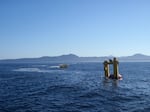
An example of a wave energy conversion device that could be tested at OSU's PacWave South facility once built.
Joe Haxel / OSU/NOAA
Federal energy regulators gave Oregon State University the go-ahead Monday for a groundbreaking wave energy testing facility off the coast of the state.
The PacWave South project is designed to facilitate and speed up the development of wave energy technology, which harnesses the motion of the ocean to generate electricity. Oregon is considered to have a high potential for wave energy generation – much higher by coastal area than Washington or California. The Oregon Department of Energy says near-shore wave energy project alone have the potential to power 28 million homes annually.
The Federal Energy Regulatory Commission issued a license to the project, but a final review period must pass before OSU gets the final go-ahead to begin construction.
“It’s huge. It’s the first license of its type to be issued in the United States,” said OSU’s Burke Hales, chief scientist on the project.
Wave energy is considered one of the next frontiers in clean and renewable energy production, but the development of the converters has been slow and sporadic. Part of the reason is the time and financial burdens it takes to acquire the permits necessary to test the new technology in the real world.
Oregon State’s project will help developers cut through a large portion of this process by offering a pre-permitted area about 6 nautical miles offshore of Newport where wave energy developers can anchor and plug in their devices to the grid.
The entire PacWave South project area will spread over about 8 square miles of ocean. It will include four testing “berths” with undersea cables to carry energy produced back to shore near Driftwood Beach State Recreation Site — although the energy production from these small tests will likely be relatively nominal compared to expectations for a full wave energy array. Within the project’s 8-square-mile area, the equipment footprint is about 2.5 square miles.
The energy developers would pay Oregon State University directly for use of the testing facility.
“We hope to be moving this summer with groundbreaking for building our shoreside facility,” Burke said, adding that the underground and under-ocean boring work needed to run the transmission lines offshore would begin this year as well. The goal it to install the offshore components of the test facility in 2022.
The project has already received two important state water quality and coastal zone approvals. The Bureau of Ocean Energy Management awarded OSU a federal lease to operate the project in mid-February.
Clarification: March 3, 2021. An earlier version of this story did not specify that the entire PacWave South project area is 8 square miles, and within this area, the project’s actual equipment footprint is about 2.5 square miles.
